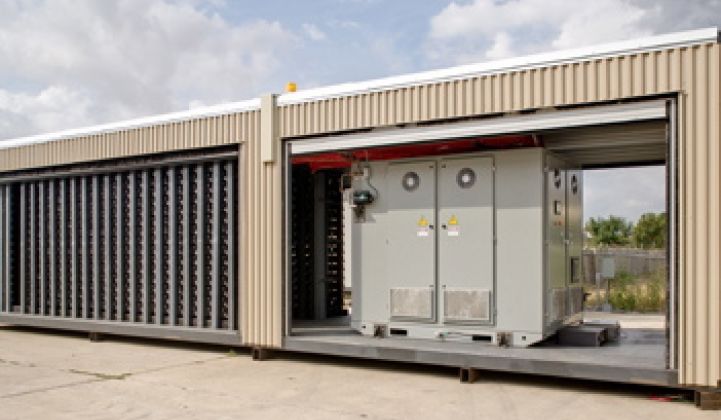I just spoke with Xtreme Power's CEO, Carlos Coe, on his way to officially commission a 15-megawatt energy storage system on First Wind’s 30-megawatt Kahuku Wind project on Oahu, Hawaii.
Coe says it's the largest energy storage system integrated with a wind farm in North America the U.S. It's also the first renewable energy project to be completed under the Department of Energy’s loan guarantee program, which supplied $117 million for construction in July 2010. The project has been operating since February in trial mode, but it goes official today.
In Coe's words, this system is different than other storage installations because "it operates in real-time to offset instantaneous power changes -- and to turn wind power from a variable supply to a nice, well-behaved power source."
We've analyzed the imperative of installing storage in the energy grid at Greentech Media. We've explored an immense range of energy storage technologies, as well as examined the challenge of the current regulatory climate. It's a complicated issue, to say the least.
In any case, most agree that we'll need distributed and centralized storage technologies in the electrical grid to allow it to be more flexible, reliable, and to accommodate the increase in variable renewables like wind and solar. One obstacle to the economic case for energy storage has been the difficulty in extracting various revenue streams from the different storage functions.
Xtreme might have solved that.
The Xtreme system on the North Shore of Oahu "smoothes the wind farm’s output to ±1 megawatt per minute" by storing or releasing power as needed so that Hawaiian Electric Company’s [HECO] grid system and its customers are isolated from disturbances due to varying winds at the Kahuku Wind wind farm. The system can firm renewables, store power when it's not needed and provide other ancillary services.
While there seems to be a focus on the price of energy storage on a per kilowatt-hour basis, Coe maintains that that is a specious argument -- because the real cost of deploying energy storage is in the power electronics, interconnection, and control systems around the central energy storage technology, whether it be Li-ion or NaS or lead acid or whatever it is that Xtreme is using.
Xtreme has been less than open in revealing its core energy storage technology. Michael Kanellos reported on the firm earlier this year and discovered from Xtreme investor Tom Cain that the core material is fiberglass -- and that it is solid.
"There is no free-flowing liquid, not gel, no paste," he said. The key to the material is that it has almost no electrical resistance, which means very little waste heat or energy lost in charging and recharging.
Coe revealed a little more this morning, saying the material was ballistic-grade fiber and that "there's about a mile of that fiber in the power cell," adding that "it's a dry cell, it's unique and the key features are pretty interesting." The battery technology was originally developed by Tracor and Ford Aerospace for electric vehicle applications.
Coe stressed that Hawaii's grid is not very flexible and the Kahuku wind farm is on a relatively weak part of that already stressed grid. Xtreme's storage product takes a potentially destabilizing element and turns into a stabilizing force, according to Coe.
Xtreme Power is backed by SAIL Venture Partners, Bessemer Venture Partners, The Dow Chemical Company, Fluor Corp., BP Alternative Energy, Dominion Resources, POSCO ICT, SkyLake & Co. and Spring Ventures. The Kahuku project is one of three collaborations between Xtreme Power and First Wind.



